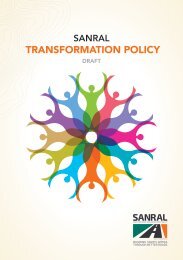Brand-South Africa - Annual report 2015 - 2016
During the past financial year, aligned with its mandate to build pride and patriotism in the Nation Brand, Brand South Africa has worked on initiatives to encourage active citizenship in partnership with its stakeholders in government, business, civil society and identified influential forums to increase the participation of all people, particularly our young people, in building a strong, cohesive Nation Brand. These activities, together with engagements at provincial level on Nation Brand alignment, contribute to social cohesion and a positive Nation Brand. Brand South Africa’s activities took place under the leadership of its new CEO, Amb. Kingsley Makhubela, PhD, who joined the organisation during the year.
During the past financial year, aligned with its mandate to build pride and patriotism in the Nation Brand, Brand South Africa has worked on initiatives to encourage active citizenship in partnership with its stakeholders in government, business, civil society and identified influential forums to increase the participation of all people, particularly our young people, in building a strong, cohesive Nation Brand. These activities, together with engagements at provincial level on Nation Brand alignment, contribute to social cohesion and a positive Nation Brand.
Brand South Africa’s activities took place under the leadership of its new CEO, Amb. Kingsley Makhubela, PhD, who joined the organisation during the year.
You also want an ePaper? Increase the reach of your titles
YUMPU automatically turns print PDFs into web optimized ePapers that Google loves.
• those that provide evidence of conditions that existed at<br />
the <strong>report</strong>ing date (adjusting events after the <strong>report</strong>ing<br />
date); and<br />
• those that are indicative of conditions that arose after the<br />
<strong>report</strong>ing date (non-adjusting events after the <strong>report</strong>ing<br />
date).<br />
<strong>Brand</strong> SA adjusts the amount recognised in the Financial<br />
Statements to reflect adjusting events after the <strong>report</strong>ing date<br />
once the event occurred.<br />
<strong>Brand</strong> SA discloses the nature of the event and an estimate<br />
of its financial effect or a statement that such estimate cannot<br />
be made in respect of all material non-adjusting events, where<br />
non-disclosure could influence the economic decisions of users<br />
taken on the basis of the Financial Statements.<br />
2. New standards and<br />
interpretations<br />
2.1 Standards and interpretations issued, but<br />
not yet effective<br />
<strong>Brand</strong> SA has not applied the following standards and<br />
interpretations, which have been published and are mandatory<br />
for <strong>Brand</strong> SA’s accounting periods beginning on or after<br />
1 April <strong>2016</strong> or later periods:<br />
GRAP 20: Related parties<br />
The objective of this standard is to ensure that a <strong>report</strong>ing<br />
entity’s Financial Statements contain the disclosures necessary<br />
to draw attention to the possibility that its financial position and<br />
surplus or deficit may have been affected by the existence of<br />
related parties and by transactions and outstanding balances<br />
with such parties.<br />
An entity that prepares and presents Financial Statements<br />
under the accrual basis of accounting (in this standard referred<br />
to as the <strong>report</strong>ing entity) shall apply this standard in:<br />
• identifying related party relationships and transactions;<br />
• identifying outstanding balances, including commitments,<br />
between an entity and its related parties;<br />
• identifying the circumstances in which disclosure of the<br />
items in (a) and (b) is required; and<br />
• determining the disclosures to be made about those items.<br />
This standard requires disclosure of related party relationships,<br />
transactions and outstanding balances, including commitments,<br />
in the consolidated and separate Financial Statements of the<br />
<strong>report</strong>ing entity in accordance with the Standard of GRAP on<br />
Consolidated and Separate Financial Statements. This standard<br />
also applies to individual Financial Statements.<br />
Disclosure of related party transactions, outstanding balances,<br />
including commitments, and relationships with related parties<br />
may affect users’ assessments of the financial position and<br />
performance of the <strong>report</strong>ing entity and its ability to deliver<br />
agreed services, including assessments of the risks and<br />
opportunities facing the entity.<br />
This disclosure also ensures that the <strong>report</strong>ing entity is<br />
transparent about its dealings with related parties.<br />
The standard states that a related party is a person or an entity<br />
with the ability to control or jointly control the other party,<br />
or exercise significant influence over the other party, or vice<br />
versa, or an entity that is subject to common control, or joint<br />
control. As a minimum, the following are regarded as related<br />
parties of the <strong>report</strong>ing entity:<br />
• A person or a close member of that person’s family is<br />
related to the <strong>report</strong>ing entity if that person:<br />
- has control or joint control over the <strong>report</strong>ing entity;<br />
- has significant influence over the <strong>report</strong>ing entity;<br />
- is a member of the management of the entity or its<br />
controlling entity.<br />
• An entity is related to the <strong>report</strong>ing entity if any of the<br />
following conditions apply:<br />
- the entity is a member of the same economic entity<br />
(which means that each controlling entity, controlled<br />
entity and fellow controlled entity is related to the others);<br />
- one entity is an associate or joint venture of the other<br />
entity (or an associate or joint venture of a member of an<br />
economic entity of which the other entity is a member);<br />
- both entities are joint ventures of the same third party;<br />
- one entity is a joint venture of a third entity and the<br />
other entity is an associate of the third entity;<br />
- the entity is a post-employment benefit plan for the<br />
benefit of employees of either the entity or an entity<br />
related to the entity. If the <strong>report</strong>ing entity is itself such a<br />
plan, the sponsoring employers are related to the entity;<br />
- the entity is controlled or jointly controlled by a person<br />
identified in (a); and<br />
- a person identified in (a)(i) has significant influence over<br />
that entity or is a member of the management of that<br />
entity (or its controlling entity).<br />
The standard furthermore states that related party transaction<br />
is a transfer of resources, services or obligations between the<br />
<strong>report</strong>ing entity and a related party, regardless of whether a<br />
price is charged.<br />
The standard elaborates on the definitions and identification of:<br />
• Close member of the family of a person;<br />
• Management;<br />
• Related parties;<br />
• Remuneration; and<br />
• Significant influence<br />
The standard sets out the requirements, inter alia, for the<br />
disclosure of:<br />
• Control;<br />
• Related party transactions; and<br />
• Remuneration of management<br />
The effective date of the standard is not yet set by the Minister<br />
of Finance.<br />
<strong>Brand</strong> SA expects to adopt the standard for the first time when<br />
the Minister sets the effective date for the standard.<br />
103











